Submitted:
12 June 2024
Posted:
13 June 2024
You are already at the latest version
Abstract
Keywords:
1. Introduction
2. Methods
2.1. Study Site
2.2. Field Methods
2.3. Soil Testing for Na, Ca, Mg, pH, SAR, and EC
2.4. Data Analysis
3. Results
3.1. Descriptive Statistics of Site Conditions
3.2. Ordination Seeking Key Site Indicators
3.3. Between-Group Difference for Zones and Sodium
3.4. What Indicators Cause between-Group Differences?
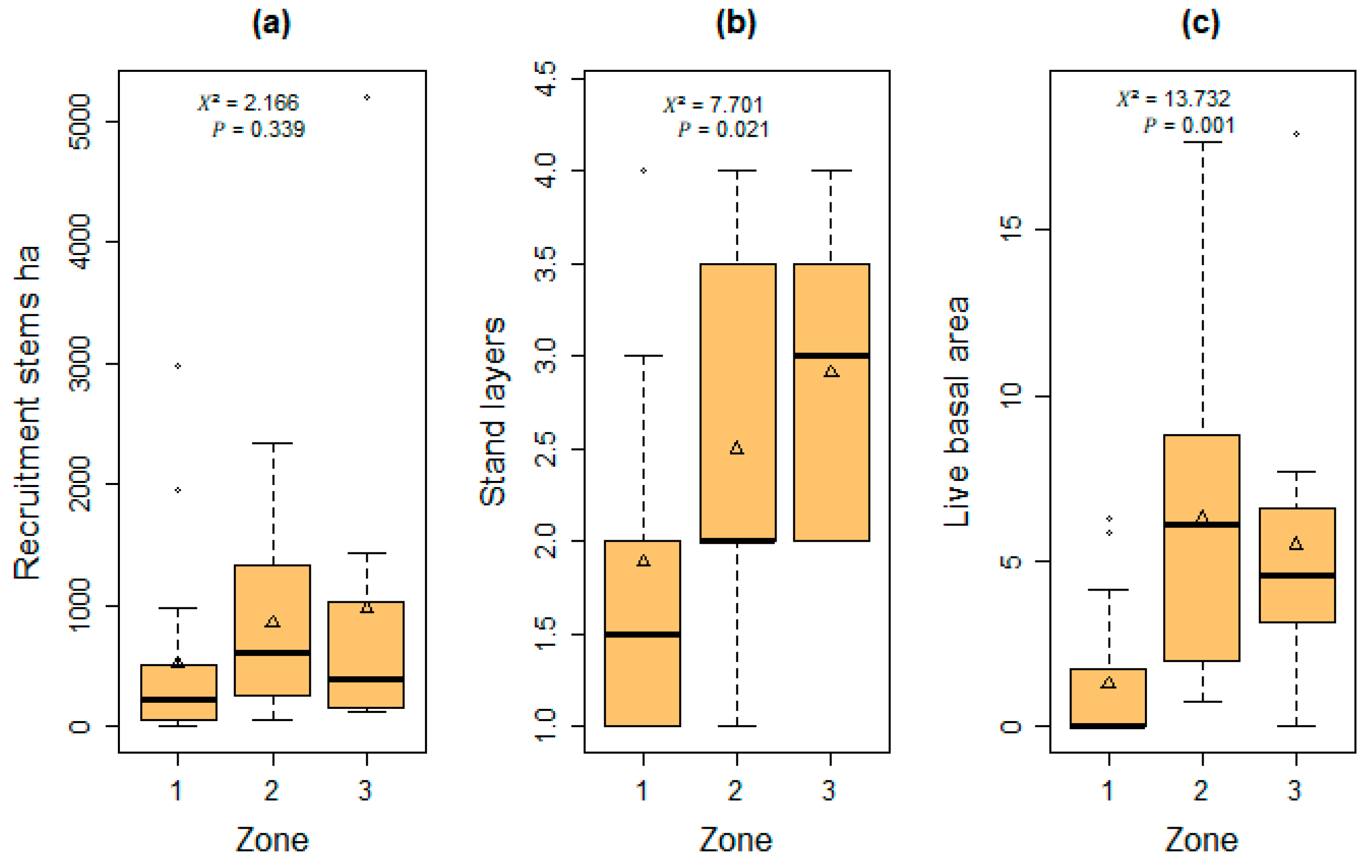
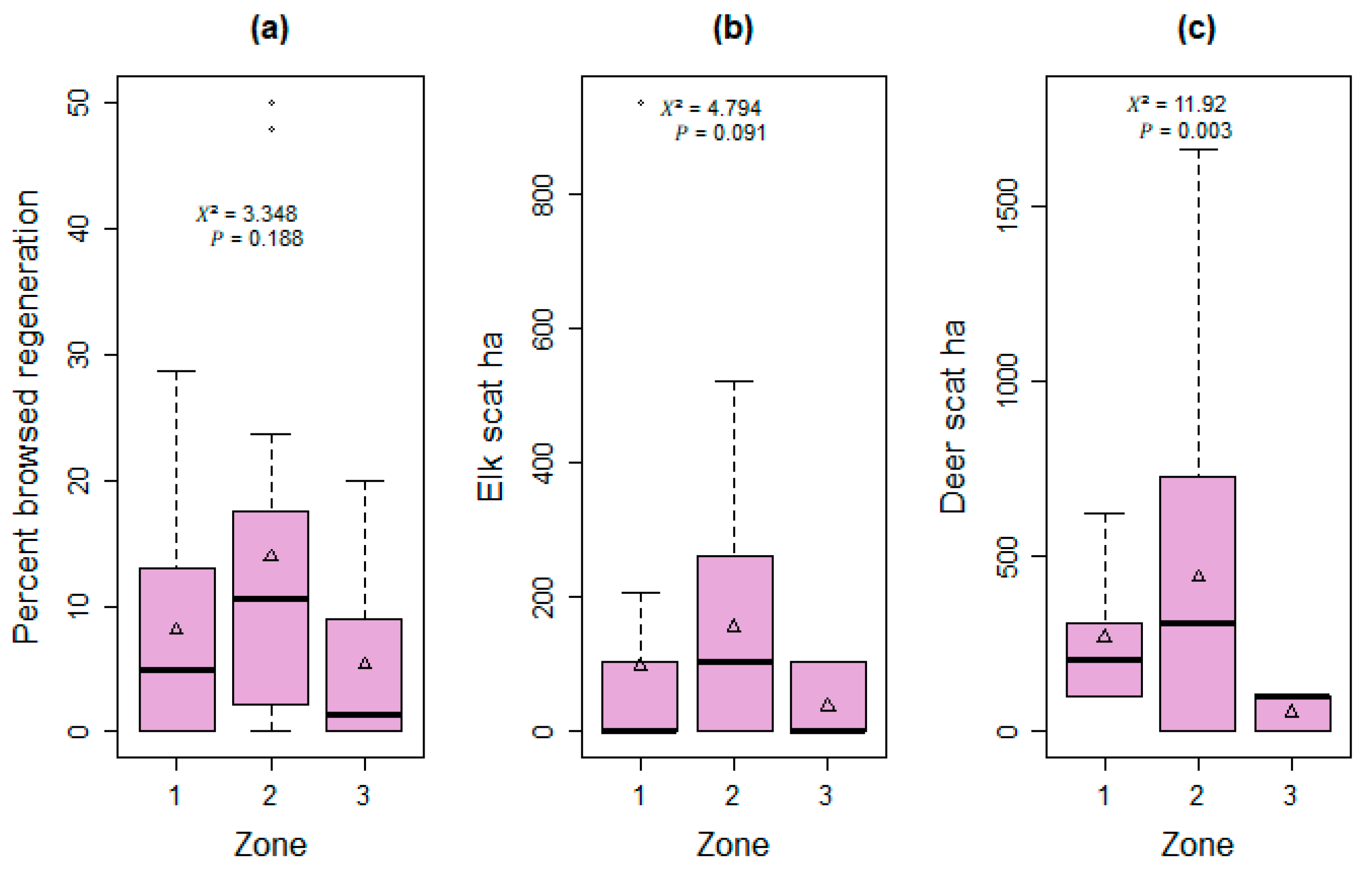
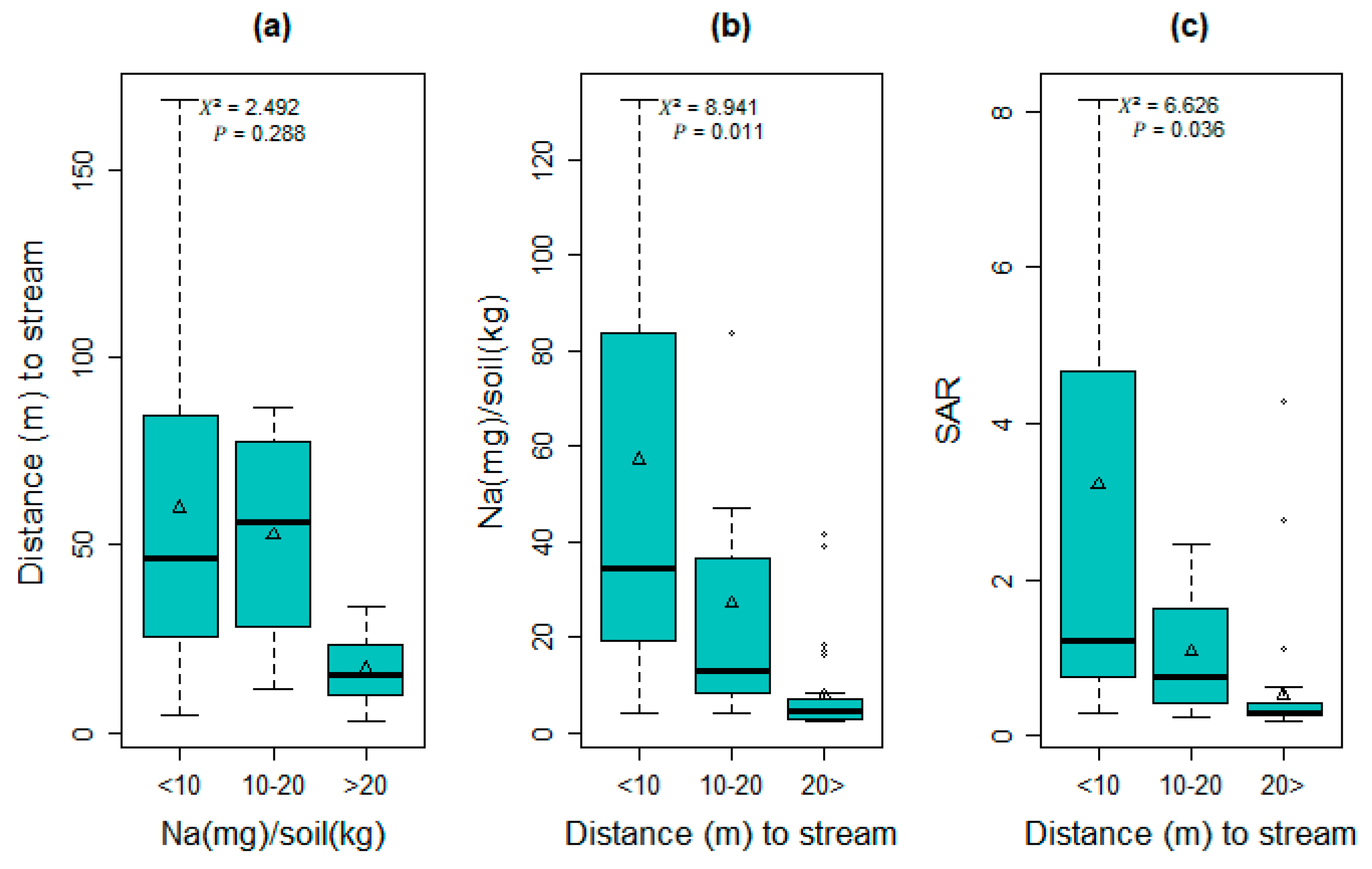
4. Discussion
4.1. How Does Aspen Condition Vary across the Study Area?
4.2. What Effect Does High-Use Recreation Have on Ungulate Presence and Aspen Conditions?
4.3. How Is Soil Contamination Impacting Aspen Communities?
4.3. How Might Area Maintenance Impact the Aspen Landscape?
5. Conclusion and Management Implications
Author Contributions
Funding
Data Availability Statement
Acknowledgments
References
- Little, E.L.; Viereck, L.A. Atlas of United States Trees:(No. 1146). Conifers and Important Hardwoods, by EL Little, Jr. 1971.
- Perala, D.A.; Burns, R.M.; Honkala, B. Populus Tremuloides Michx. - Quaking Aspen. Silvics of North America 1990, 2, 555–569. [Google Scholar]
- Angelstam, P.; Manton, M.; Pedersen, S.; Elbakidze, M. Disrupted Trophic Interactions Affect Recruitment of Boreal Deciduous and Coniferous Trees in Northern Europe. Ecological Applications 2017, 27, 1108–1123. [Google Scholar] [CrossRef]
- Edenius, L.; Ericsson, G.; Kempe, G.; Bergström, R.; Danell, K. The Effects of Changing Land Use and Browsing on Aspen Abundance and Regeneration: A 50-year Perspective from Sweden. Journal of Applied Ecology 2011, 48, 301–309. [Google Scholar] [CrossRef]
- Kota, A.M.; Bartos, D.L. Evaluation of Techniques to Protect Aspen Suckers from Ungulate Browsing in the Black Hills. Western Journal of Applied Forestry 2010, 25, 161–168. [Google Scholar] [CrossRef]
- Myking, T.; Bohler, F.; Austrheim, G.; Solberg, E.J. Life History Strategies of Aspen (Populus Tremula L.) and Browsing Effects: A Literature Review. Forestry 2011, 84, 61–71. [Google Scholar] [CrossRef]
- Usoltsev, V.; Shobairi, S.; Chasovskikh, V. Climate-Induced Gradients of Populus Sp. Forest Biomass on the Territory of Eurasia. Journal of Ecological Engineering 2018, 19, 206–212. [Google Scholar]
- Worrall, J.J.; Rehfeldt, G.E.; Hamann, A.; Hogg, E.H.; Marchetti, S.B.; Michaelian, M.; Gray, L.K. Recent Declines of Populus Tremuloides in North America Linked to Climate. Forest Ecology and Management 2013, 299, 35–51. [Google Scholar] [CrossRef]
- Bartos, D.L.; Campbell, R.B. Decline of Quaking Aspen in the Interior West--Examples from Utah. Rangelands Archives 1998, 20, 17–24. [Google Scholar]
- Di Orio, A.P.; Callas, R.; Schaefer, R.J. Forty-Eight Year Decline and Fragmentation of Aspen (Populus Tremuloides) in the South Warner Mountains of California. Forest Ecology and Management 2005, 206, 307–313. [Google Scholar] [CrossRef]
- Strand, E.K.; Vierling, L.A.; Bunting, S.C.; Gessler, P.E. Quantifying Successional Rates in Western Aspen Woodlands: Current Conditions, Future Predictions. Forest Ecology and Management 2009, 257, 1705–1715. [Google Scholar] [CrossRef]
- Rogers, P.C.; Leffler, A.J.; Ryel, R.J. Landscape Assessment of a Stable Aspen Community in Southern Utah, USA. Forest Ecology and Management 2010, 259, 487–495. [Google Scholar] [CrossRef]
- Worrall, J.J.; Egeland, L.; Eager, T.; Mask, R.A.; Johnson, E.W.; Kemp, P.A.; Shepperd, W.D. Rapid Mortality of Populus Tremuloides in Southwestern Colorado, USA. Forest Ecology and Management 2008, 255, 686–696. [Google Scholar] [CrossRef]
- Kulakowski, D.; Veblen, T.T.; Drinkwater, S. The Persistence of Quaking Aspen (Populus Tremuloides) in the Grand Mesa Area, Colorado. Ecological Applications 2004, 14, 1603–1614. [Google Scholar] [CrossRef]
- Manier, D.J.; Laven, R.D. Changes in Landscape Patterns Associated with the Persistence of Aspen (Populus Tremuloides Michx.) on the Western Slope of the Rocky Mountains, Colorado. Forest Ecology and Management 2002, 167, 263–284. [Google Scholar] [CrossRef]
- Sankey, T.T. Regional Assessment of Aspen Change and Spatial Variability on Decadal Time Scales. Remote Sensing 2009, 1, 896–914. [Google Scholar] [CrossRef]
- Rogers, P.C.; Gale, J.A. Restoration of the Iconic Pando Aspen Clone: Emerging Evidence of Recovery. Ecosphere 2017, 8, e01661. [Google Scholar] [CrossRef]
- Hedenås, H.; Ericson, L. Epiphytic Macrolichens as Conservation Indicators: Successional Sequence in Populus Tremula Stands. Biological Conservation 2000, 93, 43–53. [Google Scholar] [CrossRef]
- Oaten, D.K.; Larsen, K.W. Aspen Stands as Small Mammal “Hotspots” Within Dry Forest Ecosystems of British Columbia. Northwest Science 2008, 82, 276–285. [Google Scholar] [CrossRef]
- Rogers, P.C.; Pinno, B.D.; Šebesta, J.; Albrectsen, B.R.; Li, G.; Ivanova, N.; Kusbach, A.; Kuuluvainen, T.; Landhäusser, S.M.; Liu, H.; et al. A Global View of Aspen: Conservation Science for Widespread Keystone Systems. Global Ecology and Conservation 2020, 21, e00828. [Google Scholar] [CrossRef]
- Chong, G.W.; Simonson, S.E.; Stohlgren, T.J.; Kalkhan, M.A. Biodiversity: Aspen Stands Have the Lead, but Will Nonnative Species Take Over. Shepperd, WD; Binkley, D.; Bartos, DL; Stohlgren, TJ, 2001; 13–15. [Google Scholar]
- Hardenbol, A.A.; Junninen, K.; Kouki, J. A Key Tree Species for Forest Biodiversity, European Aspen (Populus Tremula), Is Rapidly Declining in Boreal Old-Growth Forest Reserves. Forest Ecology and Management 2020, 462, 118009. [Google Scholar] [CrossRef]
- Kuhn, T.J.; Safford, H.D.; Jones, B.E.; Tate, K.W. Aspen (Populus Tremuloides) Stands and Their Contribution to Plant Diversity in a Semiarid Coniferous Landscape. Plant Ecology 2011, 212, 1451–1463. [Google Scholar] [CrossRef]
- Assal, T.J.; Keables, M. Quaking Aspen: The Iconic and Dynamic Deciduous Tree of the Rocky Mountains. The Rocky Mountain West: a compendium of geographic perspectives, 2020; 20–28. [Google Scholar]
- Dahms, C.; Geils, B. Assessment of Forest Ecosystem Health in the Southwest. Forest Service General Technical Report; Rocky Mountain Forest and Range Experiment Station: Fort Collins, CO, 1997. [Google Scholar]
- McCool, S. Quaking Aspen and the Human Experience: Dimensions, Issues, and Challenges. Sustaining Aspen in Western Landscapes: Symposium Proceedings 2001, Proceedings RMRS-P-18, 147–160.
- Harniss, R.O.; Harper, K.T. Tree Dynamics in Seral and Stable Aspen Stands of Central Utah. Aspen Bibliography, 1982, Paper 4310.
- Rogers, P.C.; Landhäusser, S.M.; Pinno, B.D.; Ryel, R.J. A Functional Framework for Improved Management of Western North American Aspen (Populus Tremuloides Michx.). Forest Science 2014, 60, 345–359. [Google Scholar] [CrossRef]
- Kashian, D.M.; Romme, W.H.; Regan, C.M. Reconciling Divergent Interpretations of Quaking Aspen Decline on the Northern Colorado Front Range. Ecological Applications 2007, 17, 1296–1311. [Google Scholar] [CrossRef]
- Kurzel, B.P.; Veblen, T.T.; Kulakowski, D. A Typology of Stand Structure and Dynamics of Quaking Aspen in Northwestern Colorado. Forest Ecology and Management 2007, 252, 176–190. [Google Scholar] [CrossRef]
- Mueggler, W.F. Vegetation Associations in Aspen: Ecology and Management in the Western United States. USDA Forest Service, Rocky Mountain Forest and Range Experiment Station, 1985; 45–55. [Google Scholar]
- Mueggler, W.F. Age Distribution and Reproduction of Intermountain Aspen Stands. Western Journal of Applied Forestry 1989, 4, 41–45. [Google Scholar] [CrossRef]
- Crouch, C.D.; Rogers, P.C.; Moore, M.M.; Waring, K.M. Building Ecosystem Resilience and Adaptive Capacity: A Systematic Review of Aspen Ecology and Management in the Southwest. Forest Science 2023, 69, 334–354. [Google Scholar] [CrossRef]
- Britton, J.M.; DeRose, R.J.; Mock, K.E.; Long, J.N. Herbivory and Advance Reproduction Influence Quaking Aspen Regeneration Response to Management in Southern Utah, USA. Canadian Journal of Forest Research 2016, 46, 674–682. [Google Scholar] [CrossRef]
- Zeigenfuss, L.C.; Binkley, D.; Tuskan, G.A.; Romme, W.H.; Yin, T.; DiFazio, S.; Singer, F.J. Aspen Ecology in Rocky Mountain National Park: Age Distribution, Genetics, and the Effects of Elk Herbivory. Open File Report 2008, 1337. [Google Scholar]
- DeByle, N.V.; Winokur, R.P. Aspen: Ecology and Management in the Western United States; U.S. Department of Agriculture, Forest Service, Rocky Mountain Forest and Range Experiment Station: Ft. Collins, CO, 1985. [Google Scholar]
- Hessl, A.E.; Graumlich, L.J. Interactive Effects of Human Activities, Herbivory and Fire on Quaking Aspen (Populus Tremuloides) Age Structures in Western Wyoming. Journal of Biogeography 2002, 29, 889–902. [Google Scholar] [CrossRef]
- Bailey, J.K.; Schweitzer, J.A.; Rehill, B.J.; Irschick, D.J.; Whitham, T.G.; Lindroth, R.L. Rapid Shifts in the Chemical Composition of Aspen Forests: An Introduced Herbivore as an Agent of Natural Selection. Biological Invasions 2007, 9, 715–722. [Google Scholar] [CrossRef]
- Beschta, R.L.; Ripple, W.J. Large Predators and Trophic Cascades in Terrestrial Ecosystems of the Western United States. Biological conservation 2009, 142, 2401–2414. [Google Scholar] [CrossRef]
- Fairweather, M.; Tkacz, B. Monitoring Aspen Regeneration in Northern Arizona.; 1999; pp. 18–23.
- Martin; Maron, J. L. Climate Impacts on Bird and Plant Communities from Altered Animal–Plant Interactions. Nature Clim Change 2012, 2, 195–200. [Google Scholar] [CrossRef]
- Rogers, P.C.; McAvoy, D.J. Mule Deer Impede Pando’s Recovery: Implications for Aspen Resilience from a Single-Genotype Forest. PLoS ONE 2018, 13, e0203619. [Google Scholar] [CrossRef]
- Rolf, J.M. Aspen Fencing in Northern Arizona: A 15-Year Perspective. In Sustaining Aspen in Western Landscapes: Symposium Proceedings; Department of Agriculture, Forest Service, Rocky Mountain Research Station: Fort Collins, CO, 2001; Vol. Proceedings RMRS-P-18, pp. 193–196. [Google Scholar]
- Rogers, P.C.; Šebesta, J. Past Management Spurs Differential Plant Communities within a Giant Single-Clone Aspen Forest. Forests 2019, 10, 1118. [Google Scholar] [CrossRef]
- Dietrich, S.T.; MacKenzie, M.D.; Battigelli, J.P.; Enterina, J.R. Building a Better Soil for Upland Surface Mine Reclamation in Northern Alberta: Admixing Peat, Subsoil, and Peat Biochar in a Greenhouse Study with Aspen. Canadian journal of soil science 2017, 97, 592–605. [Google Scholar] [CrossRef]
- Lauer, N. Elevated Root Zone pH and NaCl Leads to Decreased Foliar Nitrogen, Chlorophyll, and Physiological Performance in Trembling Aspen (Populus Tremuloides), Green Alder (Alnus Alnobetula), Tamarack (Larix Laricina), and White Spruce (Picea Glauca). Trees 2023, 37, 1041–1054. [Google Scholar] [CrossRef]
- Lilles, E.B.; Purdy, B.G.; Chang, S.X.; Macdonald, S.E. Soil and Groundwater Characteristics of Saline Sites Supporting Boreal Mixedwood Forests in Northern Alberta. Can. J. Soil. Sci. 2010, 90, 1–14. [Google Scholar] [CrossRef]
- Tremblay, P.-Y.; Thiffault, E.; Pinno, B.D. Effects of Land Reclamation Practices on the Productivity of Young Trembling Aspen and White Spruce on a Reclaimed Oil Sands Mining Site in Northern Alberta. New Forests 2019, 50, 911–942. [Google Scholar] [CrossRef]
- Allen, J.A.; Chambers, J.L.; Stine, M. Prospects for Increasing the Salt Tolerance of Forest Trees: A Review. Tree physiology 1994, 14, 843–853. [Google Scholar] [CrossRef]
- Maas, E. Salt Tolerance of Plants. Applied Agricultural Research 1986, 1, 12–25. [Google Scholar]
- Rogers, P.C. Pando’s Pulse: Vital Signs Signal Need for Course Correction at World-Renowned Aspen Forest. Conservation Science and Practice 2022, 4, e12804. [Google Scholar] [CrossRef]
- Rogers, P.C.; Mittanck, C.M.; Ryel, R.J. Aspen Status Report and Recommendation for the Book Cliffs. 2013.
- Arnberger, A.; Hinterberger, B. Visitor Monitoring Methods for Managing Public Use Pressures in the Danube Floodplains National Park, Austria. Journal for Nature Conservation 2003, 11, 260–267. [Google Scholar] [CrossRef]
- Hughes, J.; Macdonald, D.W. A Review of the Interactions between Free-Roaming Domestic Dogs and Wildlife. Biological Conservation 2013, 157, 341–351. [Google Scholar] [CrossRef]
- Hammitt, W.E.; Cole, D.N.; Monz, C.A. Wildland Recreation: Ecology and Management; John Wiley & Sons, 2015; ISBN 1-118-39700-2.
- Miller, A.B.; Blahna, D.J.; Morse, W.C.; Leung, Y.-F.; Rowland, M.M. From Recreation Ecology to a Recreation Ecosystem: A Framework Accounting for Social-Ecological Systems. Journal of Outdoor Recreation and Tourism 2022, 38, 100455. [Google Scholar] [CrossRef]
- Eco-Visio 2019.
- National Centers for Environmental Information NOAA NCEI U.S. Climate Normals Quick Access. Available online: https://www.ncei.noaa.gov/access/us-climate-normals/#dataset=normals-annual%20seasonal%20timeframe=30 (accessed on 9 April 2024).
- Esri ArcGIS® 2022.
- Utah Geospatial Resource Center Available online:. Available online: https://gis.utah.gov/ (accessed on 16 April 2024).
- Rogers, P.C.; Mittanck, C.M. Herbivory Strains Resilience in Drought-prone Aspen Landscapes of the Western United States. J Vegetation Science 2014, 25, 457–469. [Google Scholar] [CrossRef]
- Bunnefeld, N.; Linnell, J.D.; Odden, J.; Van Duijn, M.; Andersen, R. Risk Taking by Eurasian Lynx (Lynx Lynx) in a Human-dominated Landscape: Effects of Sex and Reproductive Status. Journal of Zoology 2006, 270, 31–39. [Google Scholar] [CrossRef]
- Roberts, D.W.; Cooper, S.V. Concepts and Techniques of Vegetation Mapping. In Land classifications based on vegetation: applications for resource management; Moscow, ID, 1987; pp. 90–96.
- Gavlak, R.; Horneck, D.; Miller, R.O.; Kotuby-Amacher, J. Soil, Plant and Water Reference Methods for the Western Region. WCC-103 Publication, Fort Collins, CO, 2003, 1–207.
- Horneck, D.A.; Ellsworth, J.W.; Hopkins, B.G.; Sullivan, D.M.; Stevens, R.G. Managing Salt-Affected Soils for Crop Production. 2007.
- Davis, J.G.; Waskom, R.M.; Bauder, T.A.; Cardon, G. Managing Sodic Soils. Colorado State University Extension 2012. [Google Scholar]
- Evers, D.; Schmit, C.; Mailliet, Y.; Hausman, J.F. Growth Characteristics and Biochemical Changes of Poplar Shoots in Vitro under Sodium Chloride Stress. Journal of Plant Physiology 1997, 151, 748–753. [Google Scholar] [CrossRef]
- R Core Team R: A Language and Environment for Statistical Computing 2022.
- McCune, B.; Mefford, M.J. PC-ORD. Multivariate Analysis of Ecological Data. Version 7; MjM Software Design: Gleneden Beach, OR, 2016. [Google Scholar]
- McCune, B.; Grace, J.B.; Urban, D.L. Analysis of Ecological Communities. 2002.
- Vaske, J.J. Survey Research and Analysis; ERIC, 2019; ISBN 1-57167-879-4.
- Zar, J.H. Biostatistical Analysis. Ed. Princeton-Hall, New Jersey, 1999. [Google Scholar]
- Kruskal, J.B. Nonmetric Multidimensional Scaling: A Numerical Method. Psychometrika 1964, 29, 115–129. [Google Scholar] [CrossRef]
- Peck, J.E. Multivariate Analysis for Community Ecologists. 2010.
- Mielke, P.W.; Berry, K.J.; Johnson, E.S. Multi-Response Permutation Procedures for a Priori Classifications. Communications in Statistics - Theory and Methods 1976, 5, 1409–1424. [Google Scholar] [CrossRef]
- Oksanen, J. Ordination and Analysis of Dissimilarities: Tutorial with R and Vegan 2009.
- Norton, J. Jeannette Norton, Pers. Comm. 2023.
- Jones, B.E.; Burton, D.; Tate, K.W. Effectiveness Monitoring of Aspen Regeneration on Managed Rangelands. US Department of Agriculture, Forest Service, Pacific Southwest Region, 2005. [Google Scholar]
- Kitchen, S.G.; Behrens, P.N.; Goodrich, S.K.; Green, A.; Guyson, J.; O’Brien, M.; Tart, D. Guidelines for Aspen Restoration in Utah with Applicability to the Intermountain West; General Technical Report; U.S. Department of Agriculture, Forest Service, Rocky Mountain Research Station: Fort Collins, CO, 2019. [Google Scholar]
- Calder, W.J.; St. Clair, S.B. Facilitation Drives Mortality Patterns along Succession Gradients of Aspen-conifer Forests. Ecosphere 2012, 3, 1–11. [Google Scholar] [CrossRef]
- Visscher, D.R.; Walker, P.D.; Flowers, M.; Kemna, C.; Pattison, J.; Kushnerick, B. Human Impact on Deer Use Is Greater than Predators and Competitors in a Multiuse Recreation Area. Animal Behaviour 2023, 197, 61–69. [Google Scholar] [CrossRef]
- Parsons, A.W.; Bland, C.; Forrester, T.; Baker-Whatton, M.C.; Schuttler, S.G.; McShea, W.J.; Costello, R.; Kays, R. The Ecological Impact of Humans and Dogs on Wildlife in Protected Areas in Eastern North America. Biological Conservation 2016, 203, 75–88. [Google Scholar] [CrossRef]
- Thompson, M.J.; Henderson, R.E. Elk Habituation as a Credibility Challenge for Wildlife Professionals. Wildlife Society Bulletin (1973-2006) 1998, 26, 477–483. [Google Scholar]
- Stankowich, T. Ungulate Flight Responses to Human Disturbance: A Review and Meta-Analysis. Biological conservation 2008, 141, 2159–2173. [Google Scholar] [CrossRef]
- Beirne, C. Mammal Responses to Global Changes in Human Activity Vary by Trophic Group and Landscape [Data Files] 2024, 2691491 Bytes.
- Barker, B.; Cardon, G.; Yost, M.; Stock, M.; Creech, E.; Gale, J. Managing Saline and Sodic Soils and Irrigation Water. 2023.
- Bolu, W.H.; Polle, A. Growth and Stress Reactions in Roots and Shoots of a Salt-Sensitive Poplar Species (Populus x Canescens). Tropical Ecology 2004, 45, 161–172. [Google Scholar]
- Bradfield, E.G.; Guttridge, C.G. Effect of Night-Time Humidity and Nutrient Solution Concentration on the Calcium Content of Tomato Fruit. Sci. Hort. 1984, 207–217. [Google Scholar] [CrossRef]
- Lopez, M.V.; Satti, S.M.E. Calcium and Potassium-Enhanced Growth and Yield of Tomato under Sodium Chloride Stress. Plant Science 1996, 114, 19–27. [Google Scholar] [CrossRef]
- Lilles, E.B.; Purdy, B.G.; Macdonald, S.E.; Chang, S.X. Growth of Aspen and White Spruce on Naturally Saline Sites in Northern Alberta: Implications for Development of Boreal Forest Vegetation on Reclaimed Saline Soils. Can. J. Soil. Sci. 2012, 92, 213–227. [Google Scholar] [CrossRef]
- Khasa, P.; Hambling, B.; Kernaghan, G.; Fung, M.; Ngimbi, E. Genetic Variability in Salt Tolerance of Selected Boreal Woody Seedlings. Forest Ecology and Management 2002, 165, 257–269. [Google Scholar] [CrossRef]
- Vaario, L.-M.; Yrjälä, K.; Rousi, M.; Sipilä, T.; Pulkkinen, P. Leaf Number Indicates Salt Tolerance of Young Seedling Families of European Aspen (Populus Tremula L.) Growing in Different Soils. Silva Fenn. 2011, 45. [Google Scholar] [CrossRef]
- Landhäusser, S.M.; Lieffers, V.J. Leaf Area Renewal, Root Retention and Carbohydrate Reserves in a Clonal Tree Species Following Above-ground Disturbance. Journal of Ecology 2002, 90, 658–665. [Google Scholar] [CrossRef]
- Zier, J.L.; Baker, W.L. A Century of Vegetation Change in the San Juan Mountains, Colorado: An Analysis Using Repeat Photography. Forest Ecology and Management 2006, 228, 251–262. [Google Scholar] [CrossRef]
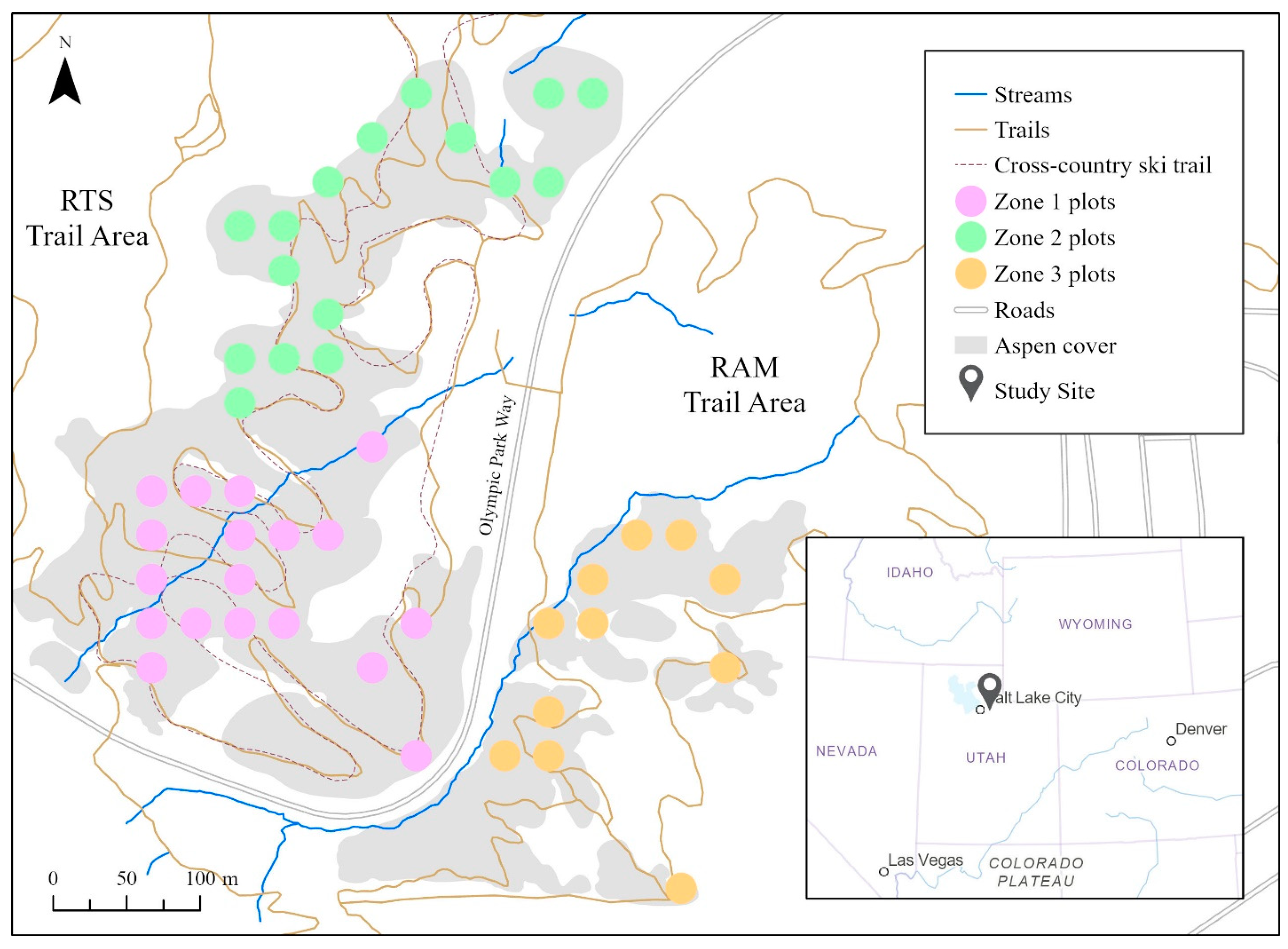
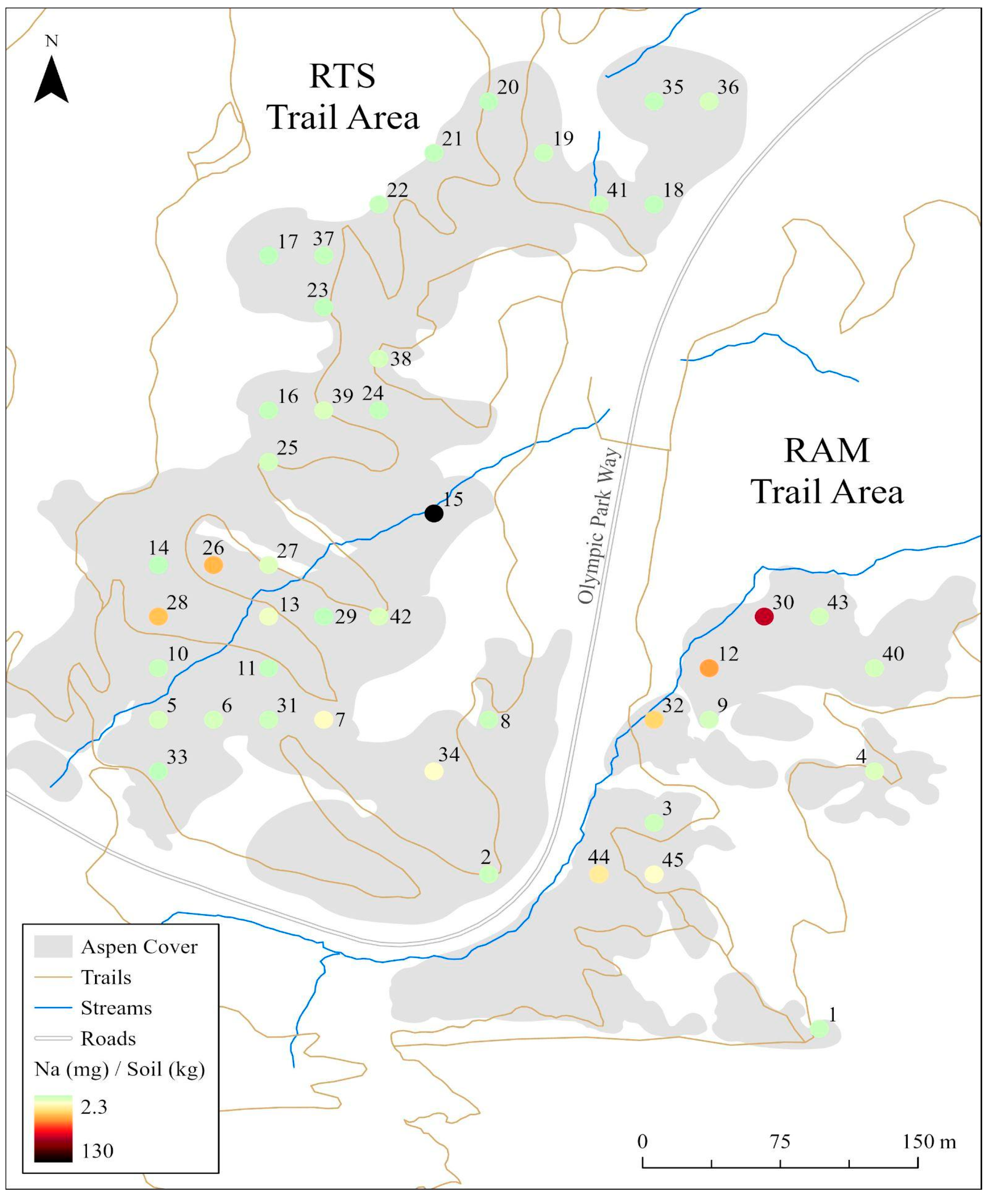
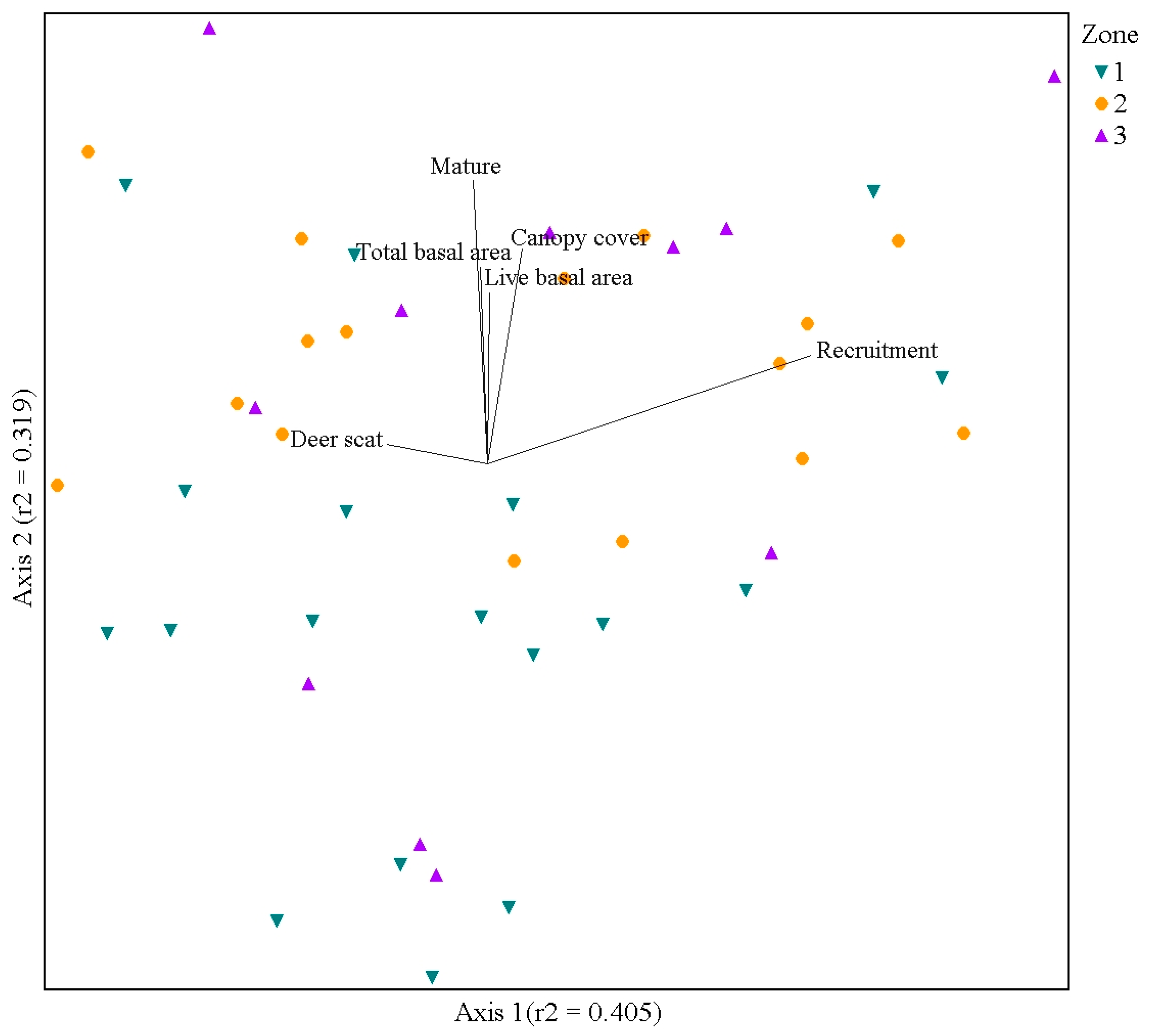
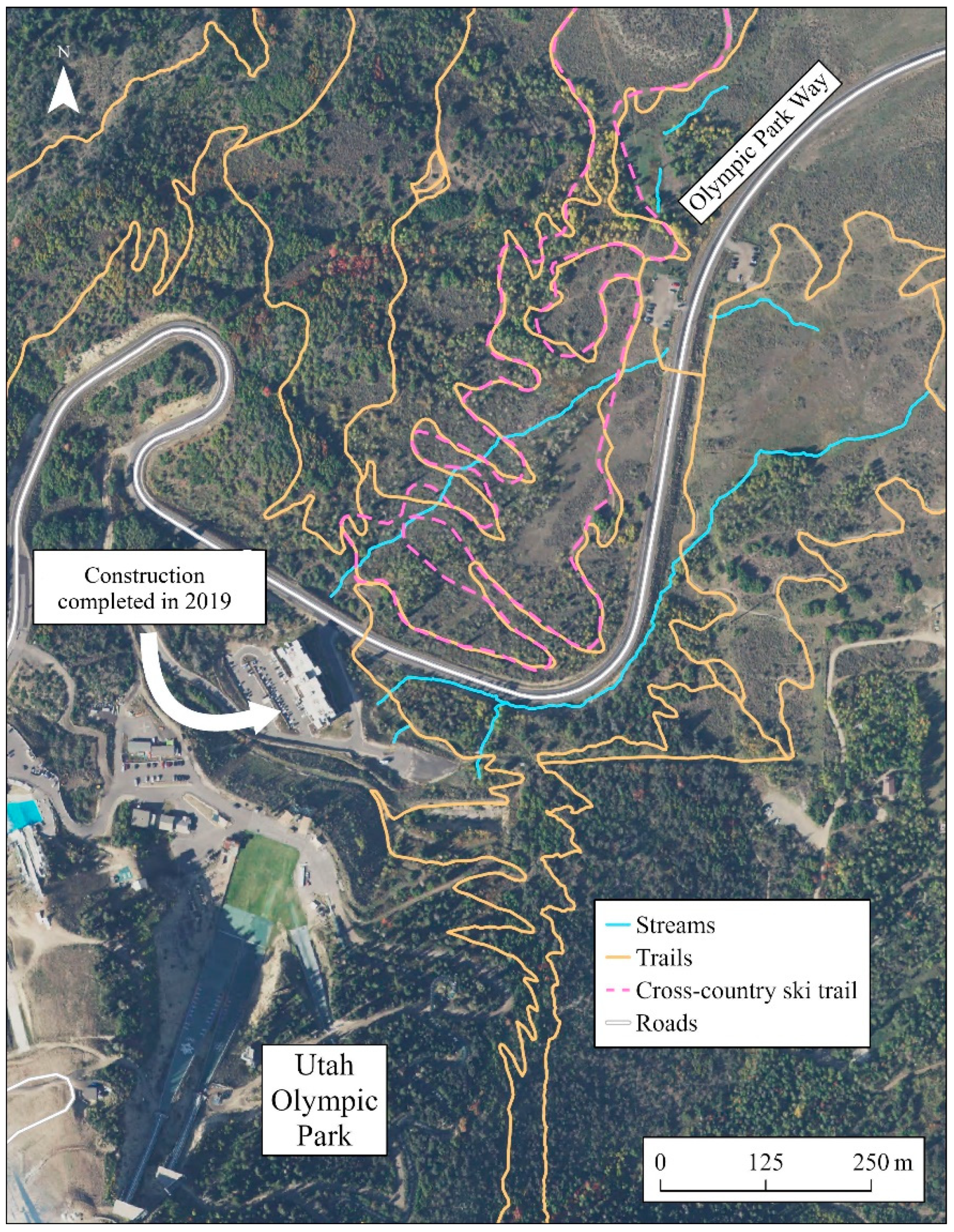
| Code | Descriptor | Overstory mortality/disease |
Vertical stand layers | Visible browse impacts |
|---|---|---|---|---|
| 1 | Good | Minimal overstory mortality and stem disease present (<5%) | Several aspen layers (>3) |
Browsing impacts on regeneration uncommon (<25%) |
| 2 | Moderate | Does not fit 1 or 3 | Does not fit 1 or 3 | Does not fit 1 or 3 |
| 3 | Poor | Overstory mortality and/or stem cankers common (>25%) | Layers absent or minimal (≥2) | Browsing impacts clearly evident on regeneration (>50%) |
| Zone 1 | Zone 2 | Zone 3 | Overall Study Area | |||||
|---|---|---|---|---|---|---|---|---|
| Variables | Mean | SD | Mean | SD | Mean | SD | Mean | SD |
| Elevation | 2,032.80 | 7.07 | 2,009.96 | 11.19 | 2,013.33 | 8.38 | 2019.92 | 13.88 |
| Slope | 7.42 | 0.75 | 8.90 | 2.66 | 7.36 | 1.55 | 7.93 | 1.93 |
| Aspect | 47.85 | 15.01 | 47.67 | 34.98 | 24.53 | 10.92 | 42.09 | 25.17 |
| Understory cover | 2.56 | 1.58 | 3.19 | 2.14 | 3.45 | 2.50 | 3 | 2.02 |
| % canopy cover | 9.33 | 10.67 | 24.88 | 14.71 | 25.64 | 21.52 | 18.84 | 16.88 |
| Stand layers | 1.94 | 1.26 | 2.50 | 1.03 | 2.91 | 0.83 | 2.38 | 1.13 |
| Stand condition | 2.50 | 0.62 | 1.94 | 0.77 | 2.27 | 0.65 | 2.24 | 0.71 |
| Regeneration ha-1 | 4,626.60 | 4,021.88 | 3,483.48 | 2,040.32 | 5,344.44 | 5,780.35 | 4395.63 | 3976.43 |
| Recruitment ha-1 | 523.29 | 772.96 | 860.72 | 719.66 | 974.40 | 1,477.04 | 753.54 | 970.2 |
| Mature ha | 256.23 | 250.57 | 430.36 | 279.53 | 578.73 | 466.13 | 396.98 | 342.12 |
| Recruitment-mature ha-1 ratio | 3.86 | 5.11 | 3.51 | 4.34 | 2.38 | 3.00 | 3.36 | 4.33 |
| Live and dead basal area | 3.97 | 3.03 | 9.44 | 6.01 | 9.58 | 7.20 | 7.28 | 5.93 |
| Live basal area | 1.30 | 2.16 | 6.30 | 4.96 | 5.51 | 4.86 | 4.11 | 4.59 |
| Dead basal area | 2.67 | 1.75 | 3.13 | 4.59 | 4.07 | 4.86 | 3.18 | 3.74 |
| Live-total basal area ratio | 0.20 | 0.31 | 0.74 | 0.31 | 0.57 | 0.38 | 0.48 | 0.4 |
| Elk scat ha-1 | 98.22 | 224.11 | 156.00 | 165.53 | 37.82 | 52.47 | 104 | 177.38 |
| Deer scat ha-1 | 271.56 | 182.38 | 442.00 | 518.61 | 56.73 | 54.31 | 279.64 | 356.72 |
| % browse | 0.08 | 0.09 | 0.14 | 0.15 | 0.05 | 0.07 | 0.09 | 0.12 |
| % damage | 0.11 | 0.22 | 0.29 | 0.27 | 0.29 | 0.35 | 0.22 | 0.28 |
| Soil pH | 7.23 | 0.45 | 7.38 | 0.48 | 7.38 | 0.54 | 7.32 | 0.48 |
| Electrical conductivity dS/m | 0.48 | 0.19 | 0.44 | 0.17 | 0.48 | 0.21 | 0.46 | 0.18 |
| Na (mg)/soil (kg) | 17.79 | 30.96 | 4.21 | 1.85 | 22.33 | 24.84 | 14.07 | 23.87 |
| Mg (mg)/soil (kg) | 3.55 | 2.91 | 2.35 | 1.98 | 9.71 | 7.81 | 4.63 | 5.23 |
| Ca (mg)/soil (kg) | 34.78 | 19.23 | 36.62 | 20.00 | 65.75 | 37.62 | 43 | 27.8 |
| Sodium adsorption ratio | 1.07 | 1.61 | 0.28 | 0.06 | 0.83 | 0.77 | 0.73 | 1.12 |
| Meters to road | 110.43 | 44.79 | 136.11 | 58.69 | 93.08 | 52.53 | 115.32 | 53.55 |
| Meters to summer trials | 13.36 | 11.33 | 17.12 | 19.23 | 21.85 | 17.94 | 16.77 | 16.13 |
| Meters to winter trials | 8.46 | 8.29 | 16.11 | 19.59 | 19.39 | 17.44 | 13.85 | 15.75 |
| Meters to stream | 35.01 | 23.09 | 75.79 | 46.62 | 47.38 | 49.88 | 52.53 | 42.91 |
| r | |||
|---|---|---|---|
| Variable | Axis 1 | Axis 2 | Axis 3 |
| Zone | 0.143 | 0.340 | -0.377 |
| Slope | 0.053 | -0.154 | 0.081 |
| Aspect | -0.154 | 0.047 | -0.086 |
| Understory | 0.079 | 0.207 | 0.040 |
| Percent canopy cover | 0.264 | 0.658 | -0.397 |
| Stand layers | 0.338 | 0.462 | -0.237 |
| Stand condition | -0.253 | -0.293 | -0.028 |
| Recruitment ha-¹ | 0.806 | 0.466 | 0.218 |
| Mature ha-¹ | -0.171 | 0.755 | -0.356 |
| Total basal area | -0.122 | 0.629 | -0.236 |
| Live basal area | 0.058 | 0.587 | -0.347 |
| Dead basal area | -0.263 | 0.276 | 0.052 |
| Elk scat ha-¹ | -0.357 | 0.122 | 0.518 |
| Deer scat ha-¹ | -0.449 | 0.197 | 0.685 |
| % browse | -0.296 | 0.210 | 0.277 |
| % damage | 0.234 | 0.280 | 0.043 |
| Soil pH | 0.060 | 0.333 | 0.113 |
| Electrical conductivity (EC) | 0.260 | -0.259 | 0.393 |
| Na (mg)/soil (kg) | -0.251 | 0.207 | -0.32 |
| Mg (mg)/soil (kg) | -0.212 | 0.170 | -0.459 |
| Ca (mg)/soil (kg) | -0.152 | 0.221 | -0.411 |
| Sodium adsorption ratio (SAR) | -0.184 | 0.058 | -0.193 |
| Meters from road | 0.148 | 0.406 | 0.131 |
| Meters from summer trail | -0.220 | 0.398 | 0.225 |
| Meters from winter trail | -0.262 | -0.038 | 0.153 |
| Meters from stream | -0.017 | -0.038 | 0.052 |
| Cumulative value | 0.405 | 0.319 | 0.158 |
| Zone | T | A | p |
|---|---|---|---|
| Zone 1 vs Zone 2 | -2.49 | 0.03 | 0.025 |
| Zone 1 vs Zone 3 | -1.88 | 0.03 | 0.052 |
| Zone 2 vs Zone 3 | -3.40 | 0.04 | 0.008 |
| Soil Sodium Levels | |||
| Low vs Medium | -0.83 | 0.01 | 0.18 |
| Low vs High | -2.70 | 0.04 | 0.02 |
| Medium vs High | -0.45 | 0.01 | 0.26 |
Disclaimer/Publisher’s Note: The statements, opinions and data contained in all publications are solely those of the individual author(s) and contributor(s) and not of MDPI and/or the editor(s). MDPI and/or the editor(s) disclaim responsibility for any injury to people or property resulting from any ideas, methods, instructions or products referred to in the content. |
© 2024 by the authors. Licensee MDPI, Basel, Switzerland. This article is an open access article distributed under the terms and conditions of the Creative Commons Attribution (CC BY) license (https://creativecommons.org/licenses/by/4.0/).





